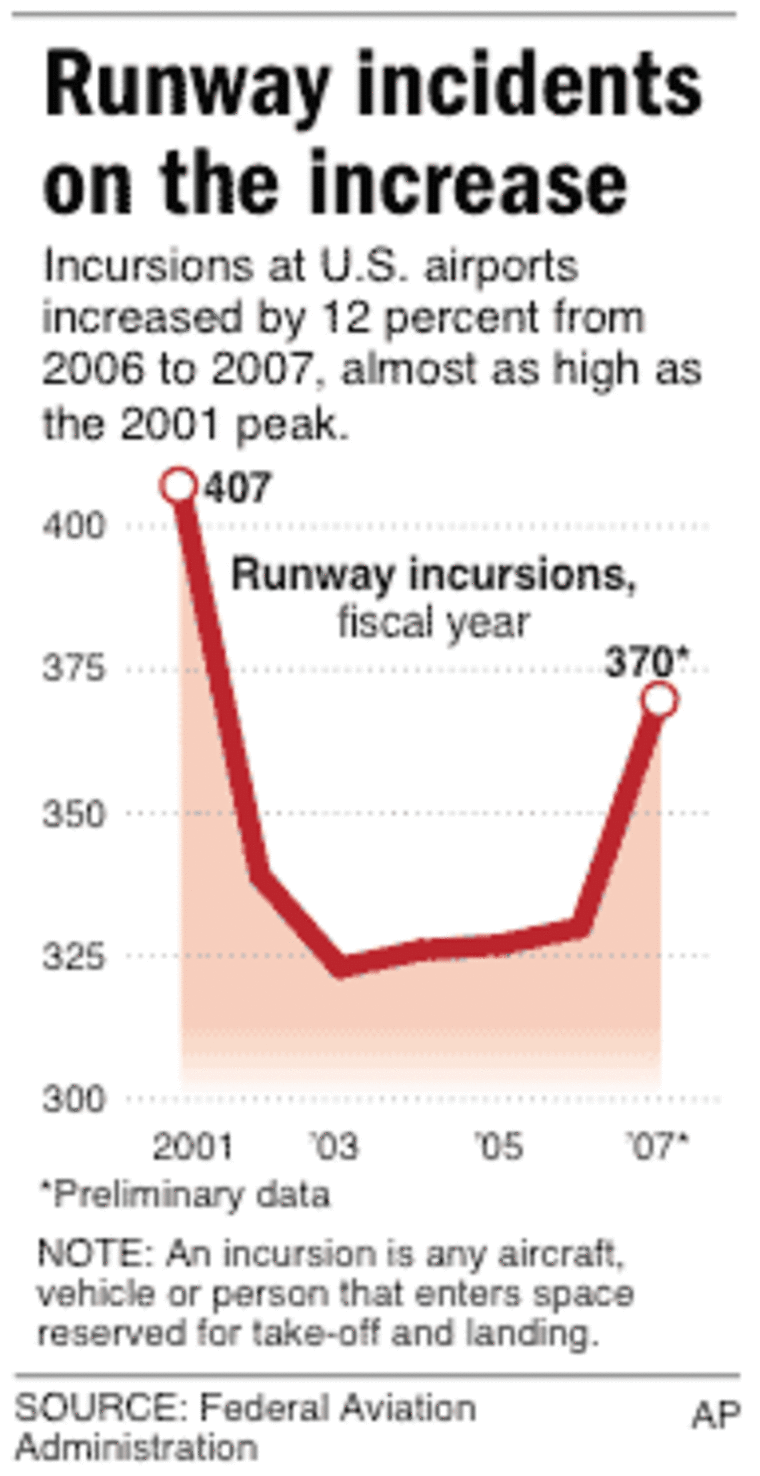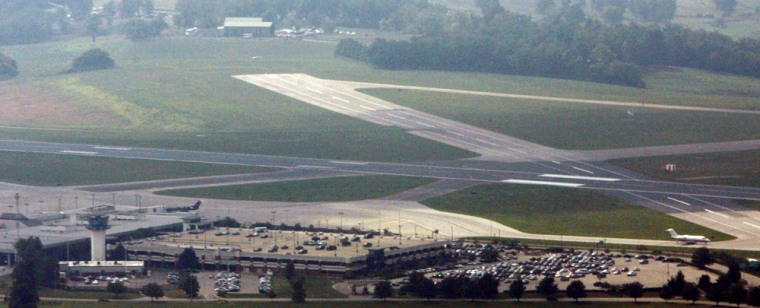Air travelers face a high risk of a catastrophic collision on U.S. airport runways because of faltering federal leadership, malfunctioning technology and overworked controllers, congressional investigators said Wednesday.
The investigators gave the Federal Aviation Administration credit for reducing runway safety incidents from a peak in 2001. But they said the agency’s “runway safety efforts subsequently waned” as the number of incidents settled at a lower level.
Then, in the 2007 budget year that ended Sept. 30, the incidents spiked to 370 — 6.05 incidents per 1 million air traffic control operations. That approached the level in 2001, when there were 407 runway incursions and 6.1 rate. An incursion is any aircraft, vehicle or person that goes where it should not be in space reserved for takeoff or landing.
At this time, “no single office is taking charge of assessing the causes of runway safety problems and taking the steps needed to address those problems,” the Government Accountability Office said in a report requested by Rep. Jerry F. Costello, D-Ill., and Sen. Frank R. Lautenberg, D-N.J.
Then-Federal Aviation Administrator Marion Blakey stepped into that leadership void in August by calling an industrywide conference to produce ideas for quick action. In October, the FAA reported progress on recommendations from the conference, including speeding improved runway markings and pilot training. The GAO report approved of those moves but also recommended more leadership from the FAA, better data collection and less overtime required of controllers.
“This report makes clear that the Bush administration is cutting corners and failing to put passenger safety first,” Lautenberg said. “The FAA is taking too many chances and ignoring too many red flags.”
Serious incursions, where a collision was narrowly averted, declined to a record low 24 in 2007, compared with 31 the year before. But the report said they have stayed high enough to pose “a high risk of a catastrophic runway collision.”
In response to the report, the FAA said it had reached its goal of reducing the most serious incursions by almost 25 percent in 2007. The agency said the overtime was a short-term issue that could be resolved through stepped-up hiring.
Hiring is focusing on two dozen facilities with high overtime or six-day work weeks, according to the FAA, and a working group is studying whether scheduling changes could minimize fatigue.
FAA spokeswoman Laura Brown said runway safety is a priority and the agency “is safely staffing all of its air traffic facilities.”
To Costello, “When there is great public attention and attention by the Congress, then the FAA acts. As soon as the attention goes away, the FAA reduces their attention.” He is chairman of the House Transportation and Infrastructure subcommittee on aviation.

Costello and Democratic Rep. James Oberstar of Minnesota, the full committee chairman, urged quick approval of a House-passed FAA bill that would provide $42 million for incursion reduction and $72 million for runway lighting; require an FAA runway safety and technology plan; and force the FAA to reopen contract negotiations with controllers. The Bush administration opposes that provision.
Since 1990, 63 people have died in six U.S. runway collisions. The FAA’s previous definition did not classify some serious runway errors as incursions, including an Aug. 27, 2006, crash in Lexington, Ky., of a Comair jet that took off from a too-short runway, killing 49.
This year has seen dramatic near-misses:
- On Aug. 16, two commercial jets carrying 296 people came within 37 feet of colliding at Los Angeles International.
- A Delta Boeing 757 touched down in Fort Lauderdale, Fla., on July 11 and had to take off immediately to avoid hitting a United Airbus A320 mistakenly on its runway.
- A Delta Boeing 737 landing at New York’s LaGuardia Airport on July 5 narrowly missed a commuter jet mistakenly cleared to cross its runway.
The National Transportation Safety Board is investigating those incidents, two others in Denver and one in San Francisco.
The GAO endorsed a board recommendation that the FAA reduce mandatory overtime for controllers. Since the FAA imposed a contract on the controllers’ union in 2006, experienced controllers have retired much faster than the agency predicted. The FAA also cut controller staff to respond to traffic pattern changes from airline mergers and bankruptcies.
The union says the cuts are too deep and reduce safety; the FAA says air travel has never been safer.
The GAO said 52 percent of controllers at the nation’s busiest airport, Hartsfield-Jackson Atlanta International, regularly work six-day weeks. Overall, between 20 percent and 52 percent of controllers at 25 FAA facilities, including seven of the 50 busiest towers, are on six-day weeks.
Nevertheless, “agency officials indicated that they had no plan to mitigate the effects of air traffic controller fatigue,” according to the report.
The president of the National Air Traffic Controllers Association, Patrick Forrey, noted the concerns by the safety board and the GAO about fatigue.
“How much more do we have to hear before the FAA is held accountable for the blatant disregard for safety it is showing by understaffing its facilities, working controllers past their breaking points and refusing to work with us to settle an ongoing contract negotiating impasse that has created the largest mass exodus of both veteran controllers and trainees we have seen since 1981?” he asked.
The GAO found that radar the FAA installed at 34 of the busiest airports to monitor aircraft on the ground does not work well when needed most — during heavy rain or snow. FAA’s more advanced ground-control radar, operational at only eight airports, issues false alerts of impending collisions — 41 from June 7, 2006, to May 16, 2007, at Hartsfield-Jackson Atlanta International.
The FAA’s Office of Runway Safety has not produced a national runway safety plan since 2002, went two years without a permanent director and had a 45 percent staff cut over the past four years, the GAO found.
